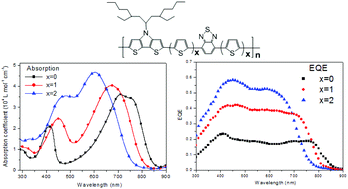Synthesis and properties of D–A copolymers based on dithienopyrrole and benzothiadiazole with various numbers of thienyl units as spacers†
Abstract
Three kinds of donor–acceptor (D–A) type semiconducting copolymers in which electron donating units of dithienopyrrole (DTP) and accepting units of benzothiadiazole (BT) were connected with different numbers of thienyl spacers (x = 0–2) were synthesized and used as electron donor materials in polymer solar cells (PSCs) combined with fullerene derivatives. The optical band gaps of the polymers could be tuned from 1.41 eV to 1.61 eV by changing the number of thiophene spacers. Electrochemical measurements showed that the increase of band gap is mainly due to the change of the lowest unoccupied molecular orbital (LUMO) energy level. The power conversion efficiency (PCE) of the polymer solar cells based on the three polymers and PC70BM reached 3.12% with x = 2 under the illumination of AM 1.5, 100 mW cm−2. This approach could provide a simple strategy for designing high-performance D–A type photovoltaic polymers based on the existing polymers and a large potential to improve their performance further.



 Please wait while we load your content...
Please wait while we load your content...